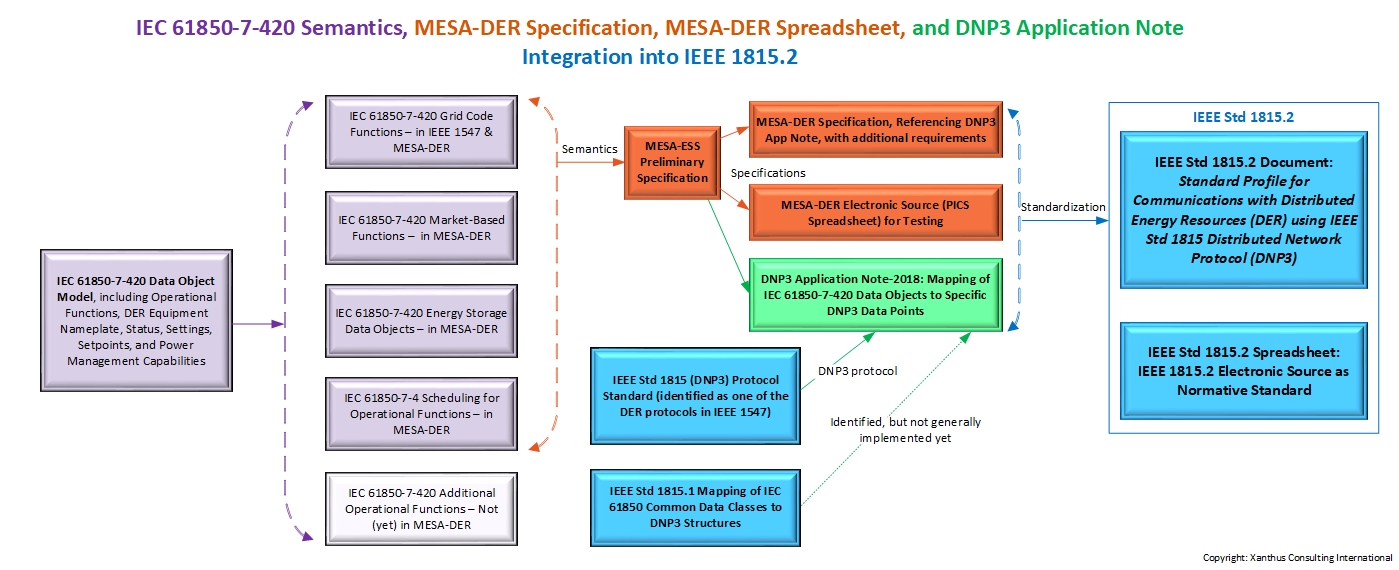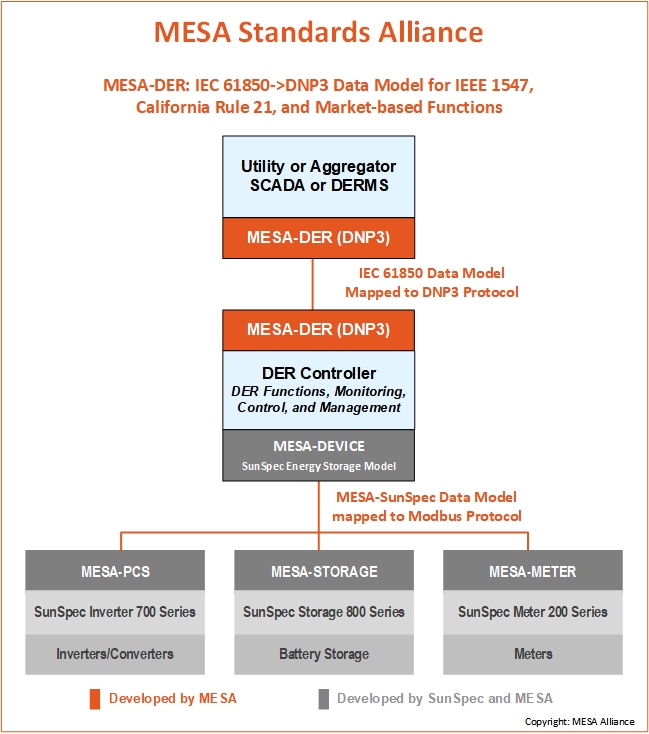MESA-DER Becoming IEEE 1815.2 Standard
The MESA-DER specification (version 1 released December 2018) defines the communication requirements for distributed energy resources (DER), with a special focus on utility-scale energy storage systems (ESS). The MESA-DER specification maps the utility SCADA protocol IEEE 1815 (DNP3) to the IEC 61850-7-420 DER information model, thus creating an interoperable profile of DER functions, monitored information, and control commands. MESA-DER is now becoming the IEEE 1815.2 Standard, with balloting expected in early 2024.
MESA-DER De Facto Standard Becoming the IEEE 1815.2 Standard
The MESA-DER de facto standard is becoming an actual standard, IEEE 1815.2, which defines the mapping between the commonly-used utility SCADA protocol IEEE 1815 (DNP3) to the IEC 61850-7-420 DER information model, thus creating an interoperable profile of DER functions, monitored information, and control commands. This MESA-DER interoperable profile is defined in the DNP3 Application Note AN2018-001 and supports all the IEEE 1547 and California Rule 21 DER functions as well as additional market-based DER functions to support utility grid safe, reliable, and efficient operations. In addition, the MESA-DER specification covers the data exchange requirements for ESS configuration management, including ESS role-based access control (RBAC) for different ESS operational states.
This multi-year process is shown below:

Basic Functions
- Monitoring Function: The DER provides status, measurements, and other requested data
- Connect/Disconnect Function: Connect or disconnect (cease to energize) the DER from the grid at its ECP
Emergency Modes
- High/Low Voltage Ride-Through Mode: The DER rides through temporary fluctuations in voltage at the PCC
- High/Low Frequency Ride-Through Mode: The DER rides through temporary fluctuations in frequency at the PCC
- Dynamic Reactive Current Support Mode: The DER reacts against rapid voltage changes to provide dynamic system stabilization
- Frequency-Watt Emergency Mode: The DER responds to large frequency excursions during H/LFRT events at a referenced ECP by changing its charging or discharging rate
Active Power Modes
- Active Power Charge/Discharge Mode: Set the DER to charge or discharge real power at the referenced ECP
- Limit Active l Power Discharging or Charging Mode: Limits the discharging or charging level of the DER based on the referenced ECP
- Load Following (Peak Power Limiting) Mode: The discharging real power output of the DER follows the load at the Referenced ECP if it starts to exceed a target power level.
- Generation Following Mode: The discharging or charging of the DER follows the generation at the referenced ECP if it starts to exceed a target power level.
- Active Power Smoothing Mode: The DER produces or absorbs real power in order to smooth the changes in the power level of the referenced ECP.
- Volt-Watt Mode: The DER responds to changes in the voltage at the referenced ECP by changing its charging or discharging rate
- Automatic Generation Control (AGC) Mode: The DER responds to raise and lower power level requests to provide frequency regulation support
- Coordinated Charge/Discharge Mode: The DER determines when to charge so long as it meets its State of Charge level obligation by the Charge-By date and time in the most cost-effective manner or based on owner preferences
- Frequency-Watt Smoothing Mode: The DER responds to changes in frequency at the referenced ECP by changing its charging or discharging rate based on frequency deviations from nominal, as a means for countering those frequency deviations
Reactive Power Modes
- Fixed Power Factor Mode: The DER power factor is set to a fixed value.
- Volt-Var Control Mode: The DER responds to changes in voltage at the referenced ECP by supplying or absorbing vars in order to maintain the desired voltage level
- Watt-Power Factor Mode: The DER responds to changes in power at the referenced ECP by changing its power factor
- Power Factor Correction Mode: The DER supplies or absorbs VArs to hold the power factor constant at the referenced ECP.
Additional Capabilities
- Scheduling of Power Settings and Modes: The DER follows the schedule which consists of a time offset (specified as a number of seconds) from the start of the schedule and is associated with a power system setting, the enabling/disabling of an operating mode, and a price signal.
- Establish Ramp Rates: In addition to the default ramp rate, the DER may support multiple ramp rates that reflect different conditions.
- Soft-Start Reconnection: Use ramp rate or random time within window when reconnecting
- Permit reconnection: Utility or other authority permits reconnection, but reconnection may or may not start at that time
- Microgrid separation control: Process for normal separation, emergency separation, and reconnection (in development)
- Provide Black Start Capability: Ability to start without grid power and the ability to add significant load in segmented groups (in development)
- Provide Backup Power: Ability to provide power to local loads when not connected to the grid
Historical Information
- DER unit status, alarms, and measurements
- Inverter status, alarms, and measurements
- Battery cells status, alarms, and measurements
- Metering status, alarms, and measurements

MESA-DER Specifications
Since MESA-DER is being converted to IEEE 1815.2, the MESA-DER specification and the DNP3 Application Note are out-of-date and are no longer available from this site.
